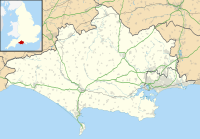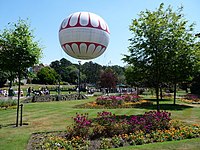| Alum Chine | |
|---|---|
 Alum Chine | |
Bournemouth, Dorset. | |
| Geography | |
| Coordinates | 50°42′50″N 1°54′00″W / 50.714°N 1.900°W |
Alum Chine is the largest chine in Bournemouth, England.[1] The gorge was crossed by a suspension bridge by the early part of the twentieth century.
History
[edit]In early maps the place was often transposed with Durley Chine.

During World War II, Robert Louis Stevenson's house Skerryvore, at the head of the chine, was severely damaged by bombs during a destructive and lethal raid on Bournemouth on the night of 15–16 November 1940. Despite a campaign to save it, the building was demolished.[2]
Namesakes
[edit]The chine gives its name to a number of local features, Alum Chine Beach being the most obvious, and to an area of the town and a telephone exchange.
A ship, the Alum Chine, destroyed in a dynamite explosion in 1913 was also named after the chine.
References
[edit]- ^ Philip Brannon (1856). The Illustrated Historical and Picturesque Guide to Poole and Bournemouth, and the Surrounding Country: Including Christchurch, Wimborne, Wareham, Corfe Castle, Swanage, and the Isle of Purbeck. Bournemouth: R. Sydenham.
- ^ Sean O'Connor (27 February 2014). Handsome Brute: The True Story of a Ladykiller. Simon and Schuster. ISBN 978-1-4711-0135-9.


Well, that’s interesting to know that Psilotum nudum are known as whisk ferns. Psilotum nudum is the commoner species of the two. While the P. flaccidum is a rare species and is found in the tropical islands. Both the species are usually epiphytic in habit and grow upon tree ferns. These species may also be terrestrial and grow in humus or in the crevices of the rocks.
View the detailed Guide of Psilotum nudum: Detailed Study Of Psilotum Nudum (Whisk Fern), Classification, Anatomy, Reproduction